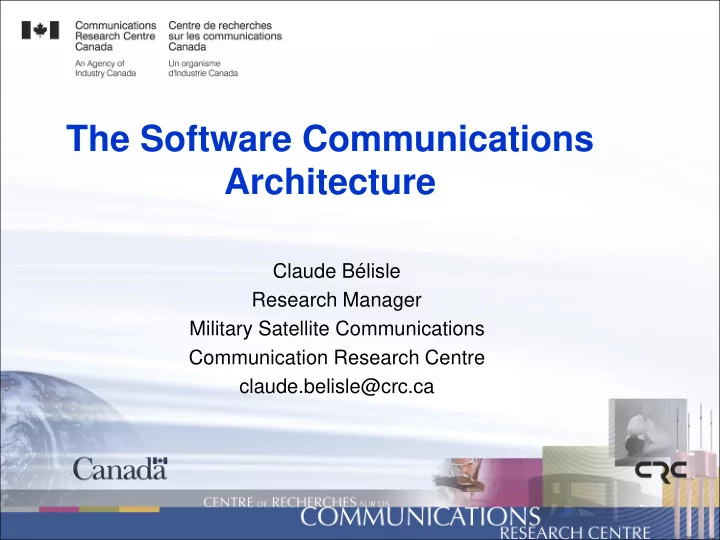

The Software Communications Architecture Claude Bélisle Research Manager Military Satellite Communications Communication Research Centre claude.belisle@crc.ca
SCA - A Paradigm shift • Decouples hardware, software and system integration functions – Facilitates acquisition process by eliminating stovepipe systems • Promotes re-use of signal processing software modules – Modulator, demodulator, encoder, interleaver, FFT… – Reduces application development cost • Open framework architecture – “Glues” the software and hardware – Facilitates application and module portability www.crc.ca
SCA Core Framework • Central radio software piece, the “ operating system ” • Provides an abstraction between software and hardware – Defines interfaces, behavioural specifications and general rules to support devices and application portability • Based on commercial standards – X.731 ITU/CCITT OSI System State Management – CORBA – Posix (Portable Operating System Interfaces) – CCM (Corba Component Model) • Designed to meet commercial as well as military application requirements www.crc.ca
SCA Design Concept www.crc.ca
SCA Core Framework • The Core Framework consists of: – Base Application Interfaces – Framework Control Interfaces – Framework Service Interfaces – Domain Profile • It specifies a life cycle for the signal processing modules to be downloaded on the hardware: – Load – Execute – Initialize – Terminate – Connect – Unload – Configure – Release www.crc.ca
Building a Reference Implementation • What is a Reference Implementation ? – Open-source software – Defines the behavior of the specifications – Codifies all of its relevant technical aspects • Benefits of RI – Reduces the level of ambiguity of the SCA specifications – Increases the potential for interoperability – Increases understanding of the architecture through an example – Reduces the cost and time-to-market of SDRs www.crc.ca
CRC and SCA-RI • Active member of SDR Forum – Participated in the development of the SRA – Involved in SCA technical discussions • Introduced the concept of Ports to enable true modularity of software components • Developed a PoC Software Defined Radio – FM Line-of-Sight – SCAv0.3 – In C++ on Digital Signal Processors (DSP) • Realized the need for an Open Source Reference Implementation – Proposal to SDR Forum to promote commercial adoption – October 2001 www.crc.ca
SCARI (1) • Implementation – SCA version 2.1 – Mandatory features – Written in Java for portability and ease of comprehension – Includes a simple waveform example • Partners – Implemented in collaboration with DRDC – Ottawa – Sponsored by the SDR Forum www.crc.ca
SCARI (2) • Product – 60,000 lines of code, 300 pages of documentation – Peer reviewed – Available at www.crc.ca/rmsc or www.crc.ca/scari – More than 7000 downloads from worldwide organizations – 37 000 hits since June 2002 • By-product – CRC submitted 21 technical change proposals to JTRS / JPO in reference to SCA version 2.2 www.crc.ca
Impact of SCARI • Opened the door to new players – No longer limited to the majors – Decoupled Hardware / Software / Waveform development • Facilitated the emergence of new markets for SDR concepts – Radar processing – Medical imagery – Other signal processing intensive applications • Transformed the waveform development approach – Modularity at component level rather than applications www.crc.ca
Waveform Development Vision • Current Approach – Extension of conventional techniques – Single monolithic block defining the application – In this case, the waveform is the application Taken from JTRS API Supplement www.crc.ca
Waveform Development Vision • Considering that software cost is: – 20% development – 80% maintenance • Development approach strongly promoted by CRC – Reduce the granularity of the software components • Similar to specialized chip sets in board design • Simplifies debug and maintainability • Facilitates reuse of components between applications www.crc.ca
Waveform Development Vision • A waveform is composed of many applications • Each application is composed of many signal processing modules (resources) www.crc.ca
Application Example Digital Audio Broadcast • Physical Layer of the DAB receiver application containing 12 resources A/D Time & Freq D-QPSK 1024 pts Converter Sync Decoding FTT Device Block Block Q-PSK Freq Demapping Decoder Deinterleave Deinterleave Viterbi Audio Time MPEG player Device Decoder Deinterleave www.crc.ca
CRC Waveform Application Builder DAB Example D-QPSK A/D Converter Time & 1024 pts Device Freq Sync Decoding FTT Block Freq Block Q-PSK Deinterleave Demapping Decoder Deinterleave Time Audio Viterbi MPEG Deinterleav Device player Decoder e www.crc.ca
Connecting Applications • Connections between applications is however required – This is supported by the SCA but mechanism not flexible enough, requires hardcoding • There is a need to transpose the resource connection mechanism to the application level – CRC will submit a change proposal to JTRS/JPO – Paper to SDRF conference to be published www.crc.ca
Following the RI • CRC continues to develop software to promote the expansion of the Software Define Radio – SDR Development Tools • Waveform Application Builder (WAB) • Radio Manager • Node Boot Builder – SCA Core Framework v2.2 • Java • Hybrid • C++ www.crc.ca
CRC SCA Core Framework v2.2 • Java – Extension of SCARI – Low cost – Most valuable for training – JTEL certification would be important for public release • Hybrid – Java for management functions, C++ for signal processing – Easy to maintain Domain Manager – Allows development of devices and resources in C++ – Mid-range cost – Applicable to embedded platforms with single board computer running Java virtual machine www.crc.ca
CRC SCA Core Framework v2.2 • C++ – Full feature implementation of SCA CF v2.2 – All C++ implementation – Applicable to embedded platforms – High cost www.crc.ca
Thank You claude.belisle@crc.ca
Recommend
More recommend